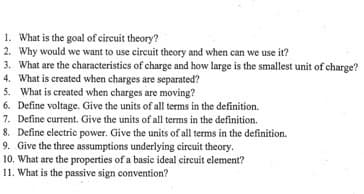1. What is the goal of circuit theory? 2. Why would we want to use circuit theory and when can we use it? 3. What are the characteristics of charge and how large is the smallest unit of charge? 4. What is created when charges are separated? 5. What is created when charges are moving? 6. Define voltage. Give the units of all terms in the definition. 7. Define current. Give the units of all terms in the definition. 8. Define electric power. Give the units of all terms in the definition. 9. Give the three assumptions underlying circuit theory. 10. What are the properties of a basic ideal circuit element? 11. What is the passive sign convention?
1. What is the goal of circuit theory? 2. Why would we want to use circuit theory and when can we use it? 3. What are the characteristics of charge and how large is the smallest unit of charge? 4. What is created when charges are separated? 5. What is created when charges are moving? 6. Define voltage. Give the units of all terms in the definition. 7. Define current. Give the units of all terms in the definition. 8. Define electric power. Give the units of all terms in the definition. 9. Give the three assumptions underlying circuit theory. 10. What are the properties of a basic ideal circuit element? 11. What is the passive sign convention?
Power System Analysis and Design (MindTap Course List)
6th Edition
ISBN:9781305632134
Author:J. Duncan Glover, Thomas Overbye, Mulukutla S. Sarma
Publisher:J. Duncan Glover, Thomas Overbye, Mulukutla S. Sarma
Chapter4: Transmission Line Parameters
Section: Chapter Questions
Problem 4.2P: The temperature dependence of resistance is also quantified by the relation R2=R1[ 1+(T2T1) ] where...
Related questions
Question
only 9

Transcribed Image Text:1. What is the goal of circuit theory?
2. Why would we want to use circuit theory and when can we use it?
3. What are the characteristics of charge and how large is the smallest unit of charge?
4. What is created when charges are separated?
5. What is created when charges are moving?
6. Define voltage. Give the units of all terms in the definition.
7. Define current. Give the units of all terms in the definition.
8. Define electric power. Give the units of all terms in the definition.
9. Give the three assumptions underlying circuit theory.
10. What are the properties of a basic ideal circuit element?
11. What is the passive sign convention?
Expert Solution
This question has been solved!
Explore an expertly crafted, step-by-step solution for a thorough understanding of key concepts.
This is a popular solution!
Trending now
This is a popular solution!
Step by step
Solved in 2 steps

Knowledge Booster
Learn more about
Need a deep-dive on the concept behind this application? Look no further. Learn more about this topic, electrical-engineering and related others by exploring similar questions and additional content below.Recommended textbooks for you

Power System Analysis and Design (MindTap Course …
Electrical Engineering
ISBN:
9781305632134
Author:
J. Duncan Glover, Thomas Overbye, Mulukutla S. Sarma
Publisher:
Cengage Learning

Delmar's Standard Textbook Of Electricity
Electrical Engineering
ISBN:
9781337900348
Author:
Stephen L. Herman
Publisher:
Cengage Learning

Power System Analysis and Design (MindTap Course …
Electrical Engineering
ISBN:
9781305632134
Author:
J. Duncan Glover, Thomas Overbye, Mulukutla S. Sarma
Publisher:
Cengage Learning

Delmar's Standard Textbook Of Electricity
Electrical Engineering
ISBN:
9781337900348
Author:
Stephen L. Herman
Publisher:
Cengage Learning